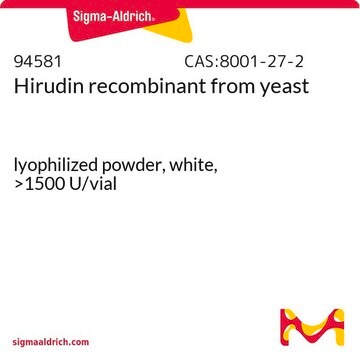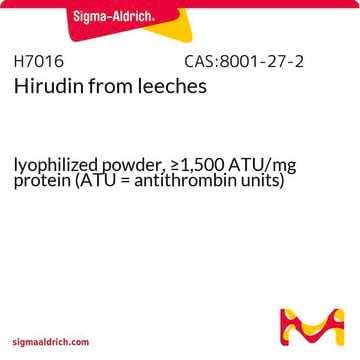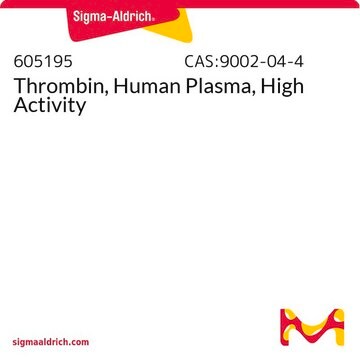H0393
Hirudin
recombinant, expressed in unspecified host, ≥7,000 ATU/mg protein, powder
About This Item
Productos recomendados
product name
Hirudin, recombinant, expressed in unspecified host, ≥7,000 ATU/mg protein (ATU = antithrombin units)
recombinant
expressed in unspecified host
Quality Level
form
powder
specific activity
≥7,000 ATU/mg protein (ATU = antithrombin units)
mol wt
~7 kDa
solubility
pyridine: soluble
water: soluble
shipped in
dry ice
storage temp.
−20°C
¿Está buscando productos similares? Visita Guía de comparación de productos
Application
Physical properties
Unit Definition
Reconstitution
Analysis Note
Storage Class
11 - Combustible Solids
wgk_germany
WGK 3
flash_point_f
Not applicable
flash_point_c
Not applicable
ppe
dust mask type N95 (US), Eyeshields, Gloves
Certificados de análisis (COA)
Busque Certificados de análisis (COA) introduciendo el número de lote del producto. Los números de lote se encuentran en la etiqueta del producto después de las palabras «Lot» o «Batch»
¿Ya tiene este producto?
Encuentre la documentación para los productos que ha comprado recientemente en la Biblioteca de documentos.
Los clientes también vieron
Nuestro equipo de científicos tiene experiencia en todas las áreas de investigación: Ciencias de la vida, Ciencia de los materiales, Síntesis química, Cromatografía, Analítica y muchas otras.
Póngase en contacto con el Servicio técnico









![PPACK, Dihydrochloride PPACK, Dihydrochloride, CAS 142036-63-3, is an extremely potent and selective irreversible inhibitor of thrombin (Kobs/[I] = 10⁷M⁻¹S⁻¹). Reacts with thrombin in a 1:1 stoichiometry.](/deepweb/assets/sigmaaldrich/product/images/403/286/e04cdb4e-07b0-4353-b8e5-13b915eae16c/640/e04cdb4e-07b0-4353-b8e5-13b915eae16c.jpg)




